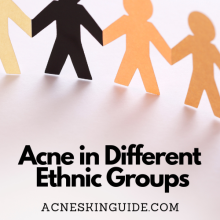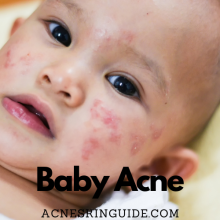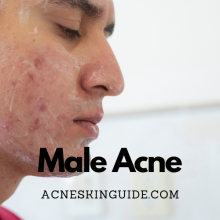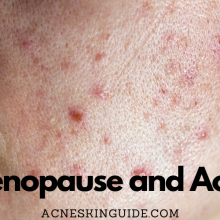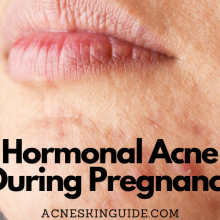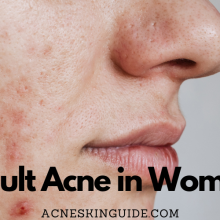Acne and Aging Skin – Managing Breakouts and Wrinkles Simultaneously | AcneSkinGuide
Summary of Acne and Aging Skin
Dealing with adult acne and visible signs of aging simultaneously can be challenging, but a comprehensive approach can help achieve a fresher, more youthful complexion. Understanding the different causes, like hormones and stress for acne, and external aggressors like UV exposure for aging, is crucial. Gentle yet effective treatments, such as retinoids, vitamin C serums, and azelaic acid, can target both concerns. However, caution is advised with stronger acne treatments, as they may exacerbate dryness and wrinkles in mature skin.
A daily skincare routine involving gentle cleansers, exfoliants, moisturizers, and sunscreen is essential. Lifestyle factors like diet, stress management, and sleep also play a role. While professional treatments like lasers and chemical peels can provide dramatic results, they often require downtime. Addressing the psychological impacts through self-care practices and support groups is equally important. With patience, commitment, and a tailored routine, it is possible to get acne breakouts and signs of aging under control.
Our Top 5 Recommended Acne Treatment Products

Struggling with Acne and Aging Skin? A Comprehensive Guide
For many adults, dealing with acne breakouts and visible signs of aging like wrinkles and age spots can feel like a brutal double whammy. While teenage acne was stressful enough, having to combat blemishes alongside emerging fine lines and sun damage feels like adding insult to injury. The good news is, with the right approach, it’s possible to get both acne and aging skin under control for a fresher, more youthful complexion.
Understanding the Causes
The first step is recognizing what’s behind your specific skincare woes. Adult acne can stem from hormonal fluctuations, high stress levels, dietary triggers like dairy or high-glycemic foods, and buildup of dead skin cells clogging pores. Aging skin, on the other hand, is largely influenced by external factors like UV exposure, pollution, smoking, and the natural loss of structural proteins like collagen and elastin over time.
While addressing internal imbalances may help adult acne, most signs of aging are due to external aggressors like free radicals and environmental stressors. However, some evidence suggests inflammation from acne can degrade collagen and elastin, leading to premature wrinkles and textural irregularities.
The Many Types of Adult Acne
Not all adult acne is the same – it can range from the occasional hormonal cystic breakout to persistent whiteheads, blackheads, and pustules. Cystic acne tends to be more difficult to treat as the inflammation originates deep within the skin. Meanwhile, comedonal acne like whiteheads and blackheads often responds better to topical treatments and chemical exfoliation.
Managing Different Signs of Aging
Just as there are varied types of acne, aging can present itself through fine lines, deep wrinkles, loss of firmness, enlarged pores, rough texture, age spots, and other concerns. Taking a multi-pronged approach using active ingredients tailored to your specific aging issues along with sun protection is key.
Finding the Right Treatments
For acne-prone aging skin, look for gentle yet effective treatments that won’t overly dry or irritate. Retinoids like adapalene can help minimize breakouts while providing anti-aging benefits by boosting cell turnover. Vitamin C serums combat discoloration from acne scarring and brighten skin. Azelaic acid is another multi-tasker, treating breakouts while fading pigmentation issues.
Potential Downsides of Certain Treatments
However, it’s important to use caution with stronger acne treatments like benzoyl peroxide and prescription retinoids as they can sometimes exacerbate dryness, irritation, and premature wrinkles in mature skin. They key is introducing active ingredients slowly and buffering with hydrating layers. Those with persistent cystic acne may need to explore medications like spironolactone or oral contraceptives after consulting a dermatologist.
For signs of aging, procedures like lasers, chemical peels, and microneedling can provide more dramatic results but often require significant downtime for healing. And more invasive options like fillers and Botox carry their own set of potential risks and side effects.
A Comprehensive Skincare Routine
Beyond targeted treatments, cultivating an effective daily skincare regimen is essential. This includes gentle gel or cream cleansers, chemical exfoliants like lactic or glycolic acid, brightening vitamin C serums, lightweight gel-cream moisturizers with ceramides, and broad-spectrum mineral SPF 30 or higher.
Managing combination skin by using oil-absorbing ingredients like clay masks on the T-zone while deeply hydrating drier areas is also important. Proper product layering and understanding which formulas are best for AM vs PM use is key to optimizing results.
Lifestyle & Natural Remedies
What you put in your body impacts your skin as much as what you put on it. An anti-inflammatory diet rich in antioxidants from fresh produce can minimize breakouts and protect against aging free radicals. Stress-reduction practices may also help, as can getting 7-9 hours of high-quality sleep per night when skin rejuvenates itself.
Simple DIY remedies like honey and turmeric masks can provide antibacterial and brightening benefits. Facial massage can improve circulation and lymphatic drainage to reduce puffiness and promote glowing skin. But avoid overly harsh scrubs or steaming that can worsen inflammatory acne.
Makeup Tips
With the right techniques and non-comedogenic makeup formulas, you can camouflage blemishes without caking product into fine lines. Look for oil-free liquid or mineral powder foundations and color correct discolorations before applying sheer, buildable coverage. Setting makeup with a finely-milled translucent powder helps blur imperfections and mattes shine.
Don’t forget to cleanse thoroughly in the evenings to remove pore-clogging makeup residue and allow skin to breathe overnight.
When to Seek a Professional
For severe or persistent acne, especially cysts, it’s wise to consult a board-certified dermatologist for prescription medications and professional treatments like chemical peels and medical-grade lasers and light therapies. Derms can also recommend aesthetic procedures to treat acne scarring such as microneedling, dermal fillers, or resurfacing procedures.
Similarly, if over-the-counter anti-aging products aren’t providing sufficient results, aesthetic treatments like radiofrequency microneedling, ultrasound therapy, or laser resurfacing may provide more dramatic wrinkle reduction and skin tightening effects.
Mind & Body
The psychological impacts of adult acne and premature signs of aging shouldn’t be overlooked. These issues can deeply affect self-esteem and confidence. Therapy, meditation, journaling, and other self-care practices can help cultivate acceptance throughout the skincare journey. Support groups allow sharing experiences in a judgment-free zone.
With commitment and a comprehensive routine tailored to your specific skincare needs, it is possible to get both acne breakouts and signs of aging under control. Be patient, listen to your skin, and make lifestyle adjustments – results won’t happen overnight but a fresher, more youthful complexion is attainable.
FAQs and Answers
Can hormonal birth control help manage both acne and aging skin?
Yes, hormonal birth control can potentially help manage both acne and aging skin in some cases. Here’s how:
For Acne:
Birth control pills that contain estrogen and progestin can help reduce acne by regulating hormone levels and lowering androgen production, which is a key factor in hormonal acne development. The FDA has approved some birth control pills specifically for acne treatment.
For Aging Skin:
Some studies suggest that birth control pills containing estrogen may have anti-aging benefits by increasing collagen production and hydration levels in the skin. Estrogen has been shown to improve skin thickness, elasticity, and wound healing.
However, it’s important to note that some progestin-only birth control methods like the mini-pill, implant, or hormonal IUD may not have the same acne-clearing or anti-aging effects since they don’t contain estrogen.
Additionally, birth control can come with potential side effects like increased risk of blood clots, mood changes, and spotting, which may outweigh the benefits for some individuals. Working closely with a dermatologist and gynecologist is recommended to determine if hormonal birth control is an appropriate option for managing both acne and aging concerns.
What types of laser treatments are most effective for reducing acne scars and wrinkles simultaneously?
There are a few different laser treatments that can be effective for simultaneously reducing acne scars and wrinkles:
- Fractional CO2 Lasers:
These ablative lasers create microscopic injuries in the skin to stimulate collagen production. They are highly effective for smoothing out acne scars and wrinkles, though there is typically more downtime involved with fractional CO2 lasers. - Non-Ablative Fractional Lasers (Fraxel):
Non-ablative fractional lasers like Fraxel create microscopic columns of heat within the skin without removing the top layer. This stimulates collagen remodeling to improve both acne scarring and wrinkles with less downtime than ablative lasers. - Pico Lasers:
Picosecond lasers use ultrashort pulses to break up pigment and scar tissue with minimal heat transfer. They can improve acne scarring as well as wrinkles and pigmentation issues often seen with aging skin. - Radiofrequency with Microneedling:
Combining radiofrequency energy with microneedling can address both textural irregularities from acne scars as well as wrinkles and lax skin through collagen induction and tightening. - Combination Therapies:
Using multiple laser types synergistically may enhance results. For example, performing a resurfacing fractional laser followed by pico laser treatments.
The ideal laser regimen depends on factors like the severity of acne scars and wrinkles as well as skin type/tone. Most treatments require multiple sessions spaced out for optimal outcomes. A consultation with an experienced provider is recommended.
Are there any supplements or nutriceuticals that can benefit both acne and aging skin?
Yes, there are several supplements and nutriceuticals that may provide benefits for both acne and aging skin concerns:
- Omega-3 Fatty Acids:
Supplements like fish oil or algae oil provide anti-inflammatory omega-3s that can help reduce acne inflammation and comedones. Omega-3s also have antioxidant properties that may protect against premature skin aging. - Zinc:
Zinc is involved in wound healing, collagen production, and has anti-inflammatory effects. It may help reduce acne by regulating oil production and inhibiting bacterial growth. Adequate zinc intake is also important for maintaining skin integrity and elasticity. - Vitamin C:
As a potent antioxidant, vitamin C can help neutralize free radicals that contribute to acne inflammation and premature aging. It also aids collagen synthesis for firmer, more youthful skin. - Green Tea Extract:
Rich in polyphenol antioxidants like EGCG, green tea supplements may help control acne by reducing sebum production and exhibiting anti-inflammatory and antimicrobial effects. The antioxidants also protect against oxidative skin aging. - Probiotics:
Probiotics support gut and immune health, which can have a positive impact on acne as well as promote anti-aging benefits through antioxidant and anti-inflammatory mechanisms. - Antioxidants (Vitamins A, E, CoQ10, Resveratrol, etc.):
Various antioxidant supplements can help neutralize free radicals and reduce oxidative stress that drives acne and extrinsic skin aging.
It’s important to discuss proper dosages and potential medication interactions with a dermatologist or physician before starting any new supplements, especially for acne. A balanced, nutrient-rich diet is also key.
How can I prevent further acne from forming while treating existing blemishes and wrinkles?
Preventing further acne breakouts while simultaneously treating existing blemishes and wrinkles requires a multi-pronged approach:
- Use Non-Comedogenic Products:
Opt for oil-free, non-comedogenic skincare products that won’t clog pores and trigger more acne. Look for formulas labeled “non-acnegenic” or check ingredients lists for pore-clogging culprits like cocoa butter, coconut oil, etc. - Gentle Exfoliation:
Regular exfoliation with alpha-hydroxy acids (AHAs) like glycolic acid or beta-hydroxy acids (BHAs) like salicylic acid helps remove dead skin cells that can bind together and clog pores. Just be cautious not to over-exfoliate. - Practice Good Hygiene:
Make sure to cleanse skin thoroughly after sweating to remove bacteria, oil, and debris. Don’t pick at existing blemishes as this can lead to further inflammation and scarring. - Spot Treat Strategically:
Use targeted blemish treatments with ingredients like benzoyl peroxide or sulfur only on active pimples, not all over the face, to avoid excessive dryness and irritation. - Consider Retinoids:
Prescription retinoids like tretinoin can help prevent new acne lesions from forming by regulating cell turnover, while also providing anti-aging benefits. - Manage Stress:
High stress levels increase inflammation and oil production, which can trigger acne flares. Try stress management techniques like meditation, exercise, or yoga. - Monitor Hormonal Influences:
For hormonal acne, birth control pills or anti-androgen medications prescribed by a dermatologist may help regulate breakouts. - Use Sun Protection:
UV exposure can worsen acne and hyperpigmentation, so use a non-comedogenic sunscreen daily to prevent further dark spots and wrinkles.
Consistency is key – it may take several months to get both the acne and signs of aging under control with a comprehensive prevention and treatment regimen.
What are the best ways to conceal acne discoloration and scarring while also diminishing the appearance of wrinkles?
Here are some of the best ways to conceal acne discoloration and scarring while also diminishing the appearance of wrinkles:
- Color Correcting
Use a green-tinted color correcting primer or concealer to neutralize redness and discoloration from acne marks before applying foundation. For hyperpigmentation or purplish scarring, use a peach or yellow-based corrector. - Brightening Products
Look for brightening serums or moisturizers containing ingredients like vitamin C, niacinamide, kojic acid, or licorice root extract. These can help fade acne discoloration over time while also giving skin a more radiant, youthful glow. - Strategic Concealing
Use a highly pigmented, full-coverage concealer in thin layers just on the areas of concern like acne scars and marks. Let it set before gently buffing edges with a damp makeup sponge for a seamless finish. - Radiance Primers
Opt for radiance-boosting, blurring face primers before foundation. The light-reflecting particles can camouflage textural irregularities from acne scars while subtly blurring fine lines and wrinkles. - Liquid/Cream Foundation
Avoid overly drying, matte foundations that can settle into lines and accentuate wrinkles. Go for liquid or cream foundations with a natural or satin finish instead. - Finely-Milled Powder
Use a finely-milled translucent setting powder with a damp makeup sponge to lightly bake or cook concealer into the skin for long-wear camouflage that won’t crease into wrinkles. - Light Reflecting Highlighter
Apply a liquid or cream highlighter with light-reflecting pigments on the high points of the face to create a subtle, flattering radiance that blurs imperfections. - Setting Sprays
Use an oil-controlling, mattifying setting spray to lock makeup in place without emphasizing texture issues or fine lines.
The key is using strategic coverage only where needed while utilizing light-reflecting formulas and techniques to blur and camouflage concerns seamlessly.

